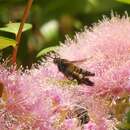Comprehensive Description
provided by Smithsonian Contributions to Zoology
Melittia amboinensis Felder
Melittia amboinensis Felder, 1861:28
Melittia doddi LeCerf, 1916, figs 3119, 3120
Melittia amboinensis var doddi LeCerf, 1917:196
Melittia thaumasia Turner, 1917:81; 1922:61 [synonymy]
MALE—Head with vertex roughened, gray-black with some white around ocelli; occipital fringe white with brown-black mixed dorsally; antennae brown-black, orange ventrally with pale yellow on porterior edge and some white powdering dorsally and anteriorly; front gray-black, white laterally and ventrally; labial palpus roughened, dorsolaterally flattened, brown-black with white ventrally and mixed mesally; scale-plate beneath scape of antenna brown-black Thorax dorsally brown-black with much yellow-orange mixed on collar, on anterior margin, above wing bases, and on posterior one-half of thorax, including metathorax and lateral tufts; ventrally mostly white Abdomen dorsally brown-black with each segment narrowly banded yellow or orange on posterior edge, often with yellow or orange powdering especially on segments 3 and 5; ventrally and laterally yellow or yellow and orange Legs with coxae and femora brown-black with white on margins; midtibia brown-black, variously banded white laterally, midtarsi brown-black, first segment white at base; hindtibia with tufts white dorsally, strongly orange laterally, brown-black ventrally, tarsal tufts mostly brown-black with some orange laterally Forewing mostly hyaline, with narrow margins, discal spot, and veins brown-black, some white powdered on apical margin; anal margin at wing base brown-black with yellow Hind-wing hyaline, with very narrow brown-black margins Wing length of male, 12–14 mm Male genitalia (Figure 13) with valva somewhat expanded apically; apical margin nearly straight, oblique, though slightly expanded ventrally; distal one-half of the valva densely covered, except for narrow area apically near ventral margin, with simple spinelike dark scales, directed basad, forming broad, very thick dark patch on distal one-fourth of valva dorsad of somewhat differentiated scale area on ventral margin, valva on mediobasal one-half with concave area outlined dorsally by thin sclerotized ridge; saccus less than one-half length of valva, relatively broadly expanded apically; uncus more narrow than tegumen, bilobed apically with dense dark scale pads on mesal surfaces; aedeagus elongate, narrow on apical one-half, expanded on basal one-half
FEMALE—Essentially exhibits same patterns and variations of maculation as male, often with more orange on thorax, tufts of hind-tibia, and powdered on some abdominal segments dorsally Wing length of female, 13–14 mm Female genitalia (Figure 23) with ostium bursae near posterior margin of segment 7; ductus bursae with very narrow sclerotized ring on posterior end, then membranous, elongate, very narrow, with ductus seminalis arising on posterior one-fourth; corpus bursae relatively small, ovate, with many folds, signum consisting of broad rugose area, pigmented on folds
MAP 4
TYPES—Unknown (M amboinensis) The following two syntypes of M doddi from the Museum National D’Histoire Naturelle were examined: (1) “TYPE”; “Melittia amboinensis Feld s sp Doddi LeCerf, Type, Et Lep comp XII fig 3119, XIV p 196, F LE CERF det 1917”; “Australie, Kuranda (Queensland) Dodd, 1907”; “[fig 3119]” (male) (2) “Allotype”; “Australie, Queensland, Kuranda, Dodd, 1913”; “Et Lep comp XII fig 3120, XIV p 196, F LE CERF det 1917”; “[fig 3120]” (female) The original description of Le Cerf (1916) consisted of two figures, a male and a female In the subsequent text volume (1917), LeCerf considered M doddi as a variation of M amboinensis and wrote, “Types: 3, 2, Australia, Kuranda (Queensland) ex Dodd (1907–1913), Coll Ch Oberthür” Despite the later publication, the type-series should consist of only the two specimens figured, and thought by us to be those listed above as syntypes The male syntype from the Museum National D’Histoire Naturelle has been selected, labeled, and is presently designated as the lectotype The following two syntypes of M thaumasia from the Australian National Insect Collection were examined: (1) “Kuranda, F P Dodd” (male) (2) “Kuranda, NQ, FPD” (sex undetermined, abdomen missing) Turner (1917) wrote, “NQ Kuranda near Cairns in January; two specimens received from Mr F P Dodd” The male syntype in the Australian National Insect Collection has been selected, labeled, and is presently designated as the lectotype
TYPE-LOCALITIES—Amboina Island (M amboinensis); Kuranda, Queensland (M doddi and M thaumasia)
HOST-PLANTS—Cucurbitaceae: Trichosanthes anguina (snake gourd) and Cephalandra indica (these hosts recorded for M amboinensis in India)
DISCUSSION—Based on our current knowledge of this complex, we do not believe the numerous color variations throughout the extensive range of M amboinensis can be construed as representing subspecies The descriptions presented here refer to the color form “doddi” LeCerf from the northern coast of Queensland The species M amboinensis occurs from India through the islands to Australia The following biological information was extracted from published accounts of M amboinensis on snake gourd in India (David and Subramaniam, 1962:192–193) The boring of the larva in the main stem or vine results in elongated galls two to three inches long and up to three-fourths inch thick Attack by this insect causes the plant to become stunted with poor foliage The mature larva leaves the gall and pupates in the soil in a specially prepared earthen cocoon, emerging as an adult in about three weeks
- bibliographic citation
- Duckworth, W. Donald and Eichlin, Thomas D. 1974. "Clearwing moths of Australia and New Zealand (Lepidoptera: Sesiidae)." Smithsonian Contributions to Zoology. 1-45. https://doi.org/10.5479/si.00810282.180
Melittia doddi: Brief Summary
provided by wikipedia EN
Melittia doddi is a moth of the family Sesiidae. It is known only from Queensland, where it was collected near Kuranda.
The length of the forewings is 12–14 mm for males and 13–14 mm for females.
- license
- cc-by-sa-3.0
- copyright
- Wikipedia authors and editors

